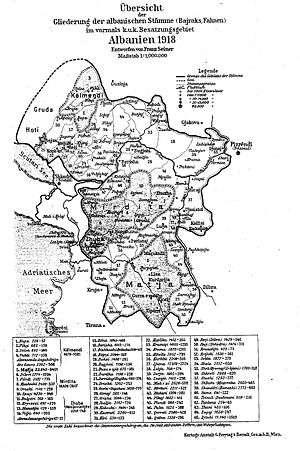Hoti (tribe)

Hoti is a historical Albanian tribe and region in Malësia, a divided region located in northern Albania and southern Montenegro.
Geography
The Hoti region lays at the Albania–Montenegro border, with the main settlements of Hot and Rapshë-Starje in Albania and Arza, Helmes and Trabojna in Montenegro.[1]
History
The term Hoti [2] was recorded as a personal name in 1330. in 1474 the region was mentioned in Latin sources as montanea ottanorum ("mountain of the Hoti").[1]
In Mariano Bolizza's 1614 report and description of the Sanjak of Scutari, Hoti had 212 households and 600 men-in-arms led by Marash Papa.[3][4]
In 1658, the seven tribes of Kuči, Vasojevići, Bratonožići, Piperi, Kelmendi, Hoti and Gruda allied themselves with the Republic of Venice, establishing the so-called "Seven-fold barjak" or "alaj-barjak", against the Ottomans.[5]
At the outset of the northern Albanian resistance against Ottoman rule, the tribe of Hoti was credited with being the first of the northern Albanian tribes to initiate the war for Albanian independence. Of particular renown was commander Ded Gjo Luli. At the victorious Battle of Deçiq, Ded Gjo Luli was able to raise the Albanian standard in symbolic defiance of Ottoman rule (the Albanian standard had not been raised since the late 15th century, during the military campaigns of Scanderbeg). Because of its instrumental role in the resistance, Hoti is commonly held as the head the Albanian tribes of Malësia, and members of the tribe are routinely given places of honor at feasts even to this day.
Religion
The majority of the Hoti are followers of the Roman Catholic faith and celebrate St. John the Baptist (Albanian: Shën Gjoni or Shnjoni) as their "feast" day. The day (August 29) commemorates the martyrdom (beheading) of Saint John the Baptist. There is also a significant minority in the region that follow Islam.
Geography
Hoti is traditionally divided into two main subdivisions: Trabojin and Rapša/Rrapshë.[6] The village of Rrapshë is divided into two, with one part belonging to Montenegro (Rapša), and the other to Albania (Rrapshë).
- Traboin / Trabojin
- Arza / Arrëz
- Helmnica / Helmnicë
- Škala / Shkallë
- Prenkaj
- Skorać / Skorraq
- Spinja / Spijë
- Trabojin / Traboin
- Stari Trabojin / Traboin Moçem
- Vuksanlekići / Vuksanlekaj
- Rrapshë / Rapša (Montenegrin side)
- Drume
- Vatnikaj
- Nikđonaj (Nikđokaj?)
- Hamala
- Božaj / Bozhaj
- Pothum / Nënhelm
- Drešaj / Dreshaj
- Mamaj (Mašaj or Mačaj?)
- Raza (Radza) / Raxë
- Vitoja / Vitojë
- Rrapshë (Albanian side)
Anthropology
There are two main branches of Hoti: Traboina and Rapsha.[7][6] According to oral tradition, the ancestor of the Hoti was a Keq preka,[8] who migrated from Bosnia.[9] Legends claim ancestral family ties with other northern Albanian and also Montenegrin tribes.[9] According to tradition collected by Edith Durham (1908), the Hoti tribe traced their origin from Bosnia, and their ancestor was a "Gheg Lazar", who arrived thirteen generations prior (est. c. 1528), fleeing the Ottomans.[10] It was said the Gruda tribe predated them.[10] The tribe was Albanophone and Roman Catholic,[10] one of five tribes of Maltsia e madhe.[11] The tribe, which was one barjak ("flag"), was made up of 500 houses, out of which only three, those of the barjaktar, were Muslim (converted seven generations prior).[10] Twelve houses descended from the Anas ("indigenous"), who the Hoti could marry.[10] Intermarriage was mostly done with the Kastrati.[11] The closest relations were held with the Kastrati, whom the Hoti traditionally married, while close relations were also held with the Triepshi and Gruda tribes.[12]
Hoti are divided into the following families:[13][14][15]
- Camaj (Camovići)
- Dedvukaj (Dedvukovići)
- Drekaj (Drekići)
- Dushaj (Dušaj, Duševići)
- Gjelaj (Đeljaj, Đeljevići)
- Gjonaj (Đonaj, Đonovići)
- Gojçaj (Gojčaj, Gojčevići)
- Junçaj (Junčaj, Junčevići)
- Lajçaj (Ljajčaj, Ljajčevići)
- Nicaj (Nicovići)
- Prelvukaj (Preljvukaj, Preljvukići)
Notable people
- Ded Gjo Luli Dedvukaj, commander of the Malisori in the Battle of Deçiq
- Çun Mula Lucgjonaj/Junçaj, flag-bearer (bajraktar)
- Palok Traboini Gojçaj, secretary of Luli
- Emina Çunmulaj, Albanian model
References
- 1 2 Elsie 2015, p. 47.
- ↑ Robert Elsie. p. 47.
- ↑ Elsie 2015, pp. 47–48.
- ↑ Early Albania:A Reader of Historical text, 11th-17th Centuries. Robert Elsie. p. 155.
- ↑ Mitološki zbornik. Centar za mitološki studije Srbije. 2004. pp. 24, 41–45.
- 1 2 Jovićević 1923, pp. 24–25
- ↑ Kenneth Bourne; David Stevenson; Donald Cameron Watt; John F. V. Keiger (1989). British Documents on Foreign Affairs--reports and Papers from the Foreign Office Confidential Print: Bulgaria, 1907-1914; Montenegro, 1895-1913. University Publications of America. p. 411. Retrieved 25 July 2013.
...the Hoti are divided into two branches, the Traboina and the Rapsha
- ↑ The Tibes of Albania,History, Society and Culture. Robert Elsie. p. 49.
- 1 2 Elsie 2015.
- 1 2 3 4 5 Durham 1909, ch. III.
- 1 2 Durham 1909, ch. II.
- ↑ Elsie 2015, p. 49.
- ↑ "Poreklo prezimena, selo Vuksanlekići (Podgorica)". Poreklo.rs (in Serbian). 12 April 2013. Retrieved 2 August 2014.
- ↑ "Poreklo prezimena, selo Sukuruć (Podgorica)". Poreklo.rs (in Serbian). 12 April 2013. Retrieved 2 August 2014.
- ↑ Jovićević 1923, pp. 23–24
- 1 2 "Prezimena u Crnoj Gori" (in Montenegrin). Montenegrin Ethnic Association of Australia. Retrieved 2 August 2014.
- ↑ "Poreklo prezimena, selo Vladni (Podgorica)". Poreklo.rs (in Serbian). 12 April 2013. Retrieved 2 August 2014.
Sources
- Durham, Edith (1909). "High Albania". London: Edward Arnold.
- Elsie, Robert (2015). The Tribes of Albania: History, Society and Culture. I.B.Tauris. pp. 49–. ISBN 978-1-78453-401-1.
